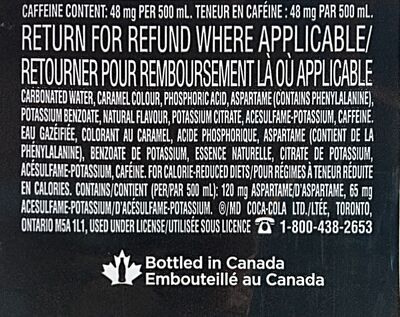Course:FNH200/Assignments/2020/Coca Cola Zero Sugar


Introduction
Coca-Cola, or Coke, is a carbonated soft drink manufactured by The Coca-Cola Company. One of the reasons why Coca-Cola has gained its popularity is that they come in various types. The most common of these is Diet Coke, along with others including Caffeine-Free Coca-Cola, Diet Coke Caffeine-Free, Coca-Cola Zero Sugar (aka Coke Zero), Coca-Cola Cherry, Coca-Cola Vanilla, and special versions with lemon, lime, and coffee. Due to recent health concerns such as weight gain, diabetes, and oral health, Coca Cola Zero with 0 sugar, 0 calories has caught many consumers' attentions. This wiki page is focused on food substitutes, food additives, food regulations and the differences between Coca-Cola Classic and Coca-Cola Zero in Canada, as well as labelling of these two products. *Reminder to TAs: Team 13 is all from Asia, therefore the images are from other media and sources.
Ingredient lists
Coca-Cola Original
- Carbonated water
- Sugar (sucrose or high-fructose corn syrup (HFCS) depending on country of origin i.e. sucrose in Canada)
- Caffeine
- Phosphoric acid
- Caramel colour (E150d)
- Natural flavourings
Coca-Cola Zero
- Carbonated water
- Caramel colour (E150d)
- Phosphoric acid
- Aspartame
- Potassium benzoate
- Natural flavours
- Potassium citrate
- Acesulfame potassium
- Caffeine
Sugar Substitutes and Additives
Coca-Cola: phosphoric acid, caramel colour (E150d), natural flavourings
Coca-Cola Zero: a blend of aspartame and acesulfame potassium (or Ace-K), phosphoric acid, potassium benzoate, natural flavourings, potassium citrate
[1]Sugar substitutes such as aspartame and acesulfame potassium are used to give Coca Cola Zero its sweetness, while having no calories. Additives for colour and flavour are used in both products, but most are not disclosed except caramel E150d, which is used as a colouring agent to colour the drink brown giving it a slight burnt taste[2]. Another additive is phosphoric acid which is used as a preservative to prevent microorganism growth and gives it an acidic flavour[3]. Potassium benzoate is used as a preservative, as well as potassium citrate is added as a pH adjusting agent to reduce and balance the tart flavour[4]. Caffeine is added as a miscellaneous agent to give a psychoactive effect.
Comparison between Coca-Cola and Coca-Cola Zero (Per 360 ml Can)
Similarities:
- Both contain carbonated water, caffeine, phosphoric acid, caramel colour (E150d), and natural flavourings.
- Appearance, aroma, and taste.
Differences:
- Coca Cola classic contain 39g of sugar and does not contain any artificial sweeteners whereas Coke zero does not contain any sugar but instead, uses artificial sweeteners aspartame and Acesulfame potassium (or Ace-K).
- Cola Cola Zero contain potassium benzoate and potassium citrate, but not in Coca Cola Zero.
- Coca cola has 140 calories whereas Coke zero has 0 calories.
- Coca cola has 5 more mg of sodium content compared to Coke zero.
- Different detriments; Coca cola is consumed by many everyday, but it might not be the best option for people with diabetes due to its high sugar content. The aspartame that’s contained in the coke zero might be harmful for those who suffer from metabolic disorder known as "PKU" (phenylketonuria).
Nutritional Information (Per 355 ml Can)
Coca-Cola:
- It has 39g of carbohydrates, which accounts for 14% of our total daily value.
- A can of Coca-Cola provides with 140 calories of energy.
- This has 25mg of sodium per serving which is 1% of our daily value.
- Other than this, it is not a significant source of saturated/trans fat, cholesterol, fiber, vitamin D, calcium and iron.
Coca-Cola Zero:
- This contains 0g of carbohydrate, therefore it can be ideal for people having hyperglycaemia or the people following a calorie deficit diet.
- A can of Coca-Cola Zero has 0 calories.
- This also has 30mg of sodium per serving which is 1% of our daily requirement.
- 0.1g of protein is contained that is from artificial sweeteners.
- Similar to the regular coke, it is not a significant source of sat/trans fat, cholesterol, fiber, vitamin D, calcium and iron.
Labelling:
[5]The labels of Coca-Cola and Coca-Cola Zero provide all the information required as per the Consumer Packaging and Labelling Act and Regulations, including:
- The common name of the food
- Country of origin (Canada)
- Irradiated food (Not marked)
- Net quantity
- Date marking (Expiration dates)
- Identity and principle of business (Phone number, name of business, etc)
- Nutritions facts (nutrition fact table per 355 ml can as the serving size of % daily value, caffeine content warning)
- Legibility and location (large and legible fonts that display the product name, ingredient lists, nutritional facts, manufacturer identity, and date marking in the appropriate locations)
- List of ingredients in descending order of proportion
Moreover, this information is present as bilingual labelling, in both French and English.
 |
 |
References
| This Food Science resource was created by Course:FNH200. |
